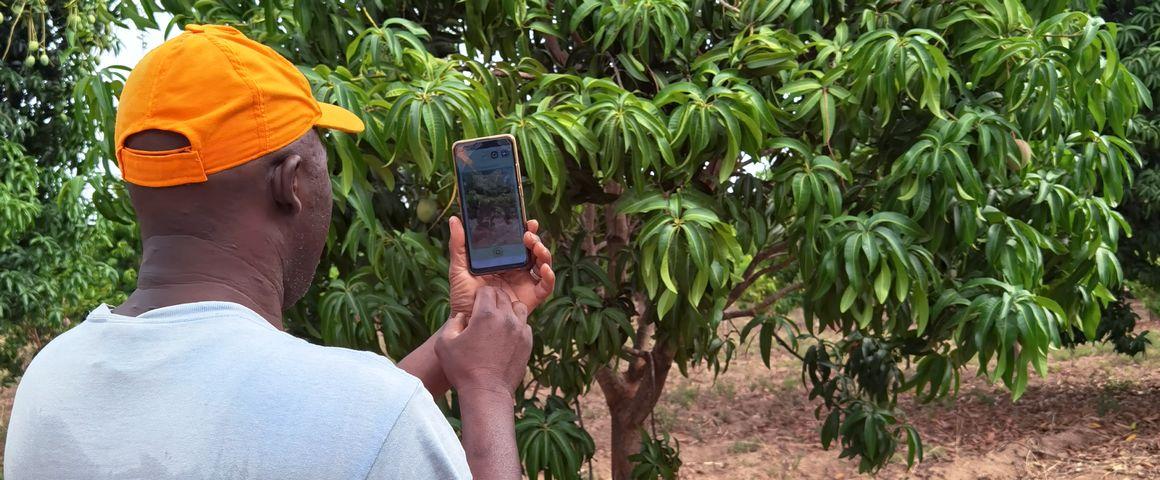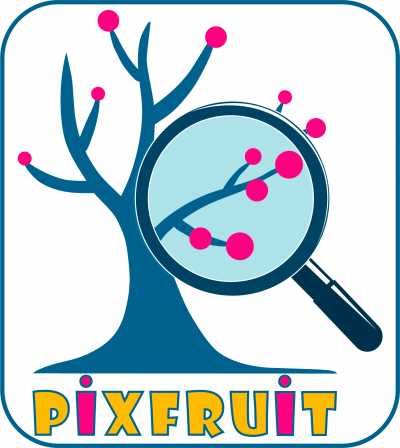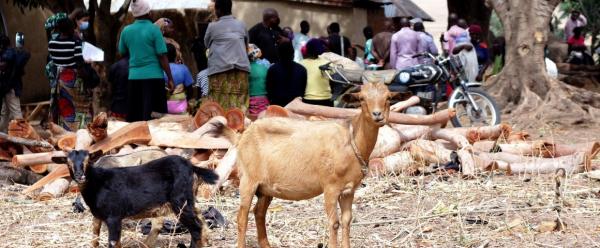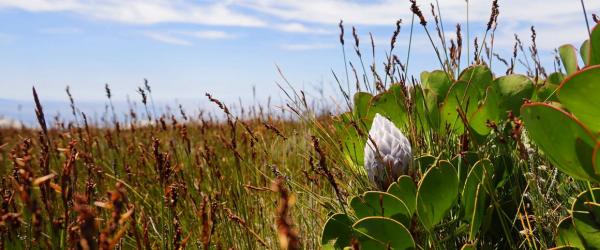Results & impact 28 October 2025
- Home
- CIRAD news
- News
- Estimate your yield via a smartphone application
A tool to rapidly estimate tropical fruit crop yields

Testing the PixFruit digital solution in a mango field in Côte d'Ivoire © J.-M. Koffi, CNRA
Behind the name “PixFruit” are years of CIRAD research and expertise in estimating tropical fruit production. Image analysis, agronomic and statistical modelling, a whole range of disciplines focusing on a single question: what if just taking a few photos was enough to quantify future yields?
“The lack of easy-to-use tools to predict the state of yields is a major obstacle to the development of fruit value chains in West Africa”, says Emile Faye, a researcher specialising in digital agroecology at CIRAD. “With PixFruit®, our goal is to meet the operational needs of stakeholders in these value chains”.
SoYield, a smartphone application to estimate yields
In 2021, the private company SOWIT and CIRAD launched an application based on the PixFruit® expertise, for use by mango sector stakeholders in Senegal: producers, harvest workers, wholesalers, buyers and exporters. They all communicated their needs and tested the tool as it was being designed and developed.
More than just a prototype, SoYield now has 400 active users in four countries: Senegal, Côte d’Ivoire, Ghana and Morocco. The application currently works for two species: mangoes and clementines, for a total of 11 varieties. It is used to estimate the yield of an orchard based on photographic sampling of a limited number of trees. Once the data has been processed by algorithms, yield indicators are provided for producers (tonnes of fruit per hectare, per variety, yield heterogeneity, fruit size, etc.), as well as for other sector stakeholders, in different forms.
Although it is currently being improved, SoYield has already proven its worth in the eyes of several producers. They are now able to estimate their yields easily and accurately, which was previously impossible or difficult. These yield estimates mean they are better equipped to sell their fruit. Where buyers are concerned, the feedback is also positive: SoYield encourages networking with producers and the shared estimation of yields makes it easier to organise the harvest year.
Different actors for the same need
Producers, buyers and public actors all need to have access to data on fruit production in order to plan and implement their actions. They need the same data, processed differently according to their requirements. Producers want accurate knowledge of their yields and to share this information with third parties: potential customers or other producers, for example. Where buyers are concerned, the geographic and temporal aspects are important: where, from whom, and when can they buy fruit of a given variety close to the processing factory? And so on. Finally, public policymakers implement their policies according to the level of productivity of agricultural areas, or to the types of orchards existing in their territories.
“What we are seeking to develop with PixFruit® are tools that meet all of these expectations”, says Emile Faye. “The underlying requirement is the same: gaining objective and accurate knowledge of orchard yields. In other words, information on fruit quantity, availability, size, harvesting date, maturity, colour, etc. The way in which this data is subsequently processed and returned makes it possible to adapt it to users’ needs”.
Improving the tool to ensure its uptake
Beyond the technical and scientific aspects of developing an application like SoYield, the biggest challenge is that of its uptake by sector stakeholders. The scientists are now addressing new questions: “for example”, says Emile Faye, “is the interface easy enough to use? Which language should we work in, French, English or local languages? Does the word “plot” mean the same thing to all users? Are personal data sufficiently protected?”.
Together, CIRAD and SOWIT are working to develop the next versions of SoYield, adapted to the constraints of the different plots. The partnership with the company is particularly fruitful and enables prompt feedback between the plots and the proposed changes.
Ultimately, CIRAD’s scientists hope to extend the field of action of PixFruit® to other crops, including coffee, cocoa, lychees and avocados, as well as to other regions: Africa as a whole, but also Latin America and Southeast Asia.
PixFruit® is one of a range of products and services developed by Cirad’Innov®, a brand dedicated to socioeconomic actors who make direct use of CIRAD’s expertise. Cirad’Innov® strives to develop environmentally friendly and socially responsible innovations in the field of sustainable agriculture: crops and livestock, but also animal health, food and food processing, or the management of natural resources and territories.
Start-ups, SMEs and large groups, professional federations, NGOs, local authorities or public agencies: the Cirad’Innov® solutions are codeveloped with different types of partners, in particular with local socioeconomic actors. Through these partnerships, CIRAD aims to improve understanding of the needs of development project beneficiaries, as well as the implementation and dissemination of solutions. The goal is to contribute together to a more sustainable and just world.




























